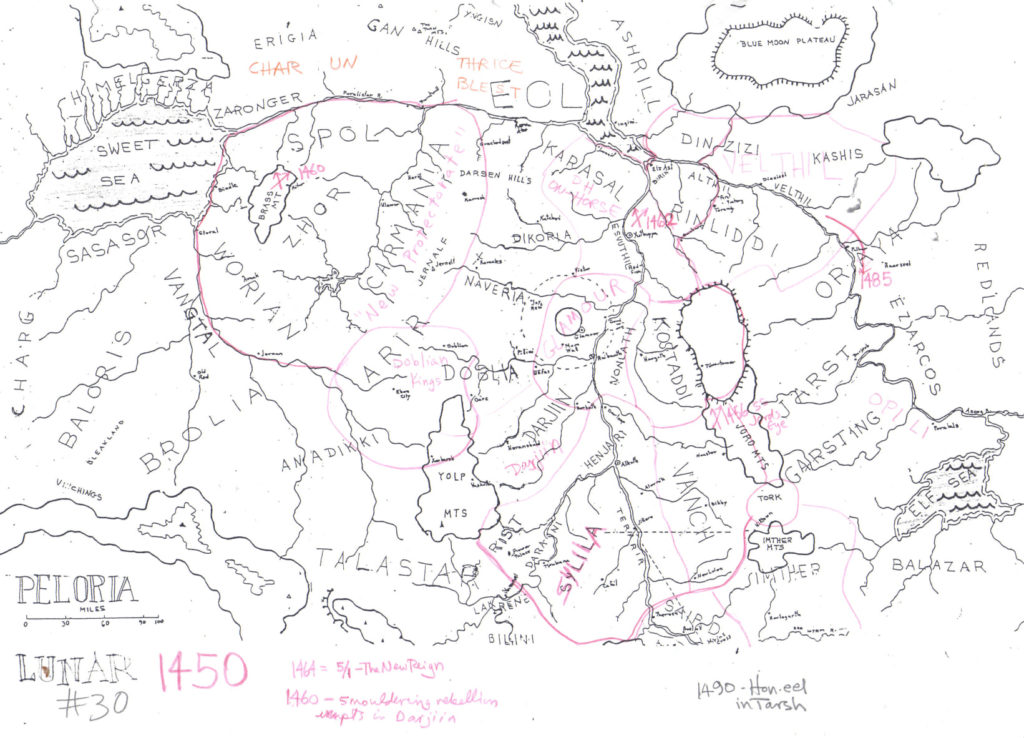Going back to our Glorantha-terrestial convergence time line, it is worth thinking that about 1775 AD Sheng Seleris and his Pentan nomads invaded Peloria. For nearly a century, Pentans dominated the Pelorian bowl, until Sheng Seleris was finally overcome by the Red Emperor in the equivalent of 1860 AD.
During that long period, much of the Pelorian bowl was depopulated, and the Pentans were unbelievably brutal and cruel to the local populations. Ancient centers of civilization and cults were destroyed. The Pentans systematically depopulated vast regions particularly in Oraya, Rinliddi, and Karasal, and the area call Dara Happa on Horse was ruled by Yelm cultists who adopted the nomad lifestyle, at least in part. Places like Doblian were ruled by their own tyrants.
Over the Fifth Wane (so basically from 1863 AD to 1917 AD) the Lunar Empire resettled and rebuilt. Oraya was settled and a more broadly “Lunar” identity appeared in the Heartlands. Many ancient lands were depopulated, and resettled, and in this way the Heartlands became more culturally united. New Pelorian became THE language in the Lunar Heartlands, and Dara Happan AKA FIrespeech, became a liturgical language. The Pentans were defeated once and for all in 1906 AD at the Battle of the Nights of Horrors. For more than a century (since 1906 AD) there has been no war in the Lunar Heartlands.
This is when the Lunar Empire we all know really came into view – only about a century ago. Although antiquarians still study the Glorious Reascent of Yelm and imagine the world through its lens, and texts like the Fortunate Succession show the old Yelmic nobility (who are now completely Lunar) that the Lunar Empire is the modern and best version of the eternal Empire, in truth, those books describe something that has long been replaced.
![]()
![]()
So when thinking about modern Lunars, remember:
1. Until recently, they have enjoyed peace in the Lunar Heartlands since about the end of WW1. That is a long period of peace, longer than the peace of the Five Good Emperors of Rome.
2. Many of the cities of the Lunar Heartlands are pretty new, being refounded in the “late 19th and early 20th century”.
3. A lot of the cultural variation in the Heartlands described in GRoY is largely gone.
So if we think about the Lunar equivalent of 1913-1967 AD (that’s the Sixth Wane), we get this:
“The great losses at the Nights of Horror impacted the imperial attitude greatly. For the last decade of the Wane talk, discussion, and debate throughout the empire questioned the events which had just occurred. The effect was, at first, merely paralyzing. Later, it brought forth a conscious withdrawal from exploratory r expansionist policies. The rulers first, and later the citizens, increased their interest in their own and neighboring cultures and styles, and shunned the foreign. The increasingly complex art styles, starting with the Orayan Fifth style, are a reflection of the increasingly internalized, complex attitude of the late Fifth, and entire Sixth Wanes”
And the Lunars view the time from the late 1960s to now as their new golden age. This is the heights of Lunar splendor. Physical and magical arts have blossomed. The fields almost grow by themselves. The Lunars don’t look backwards to the past for answers – they look forward to an ever greater future.
At least they did until a few years ago. Cracks have opened in that confident edifice. Cracks that open ever wider. And recently twin military disasters have struck the empire, shaking its resolve and confidence.
So if HonEel leads the cultural reconstruction of the Empire after Sheng is that a ‘renaissance’ period in the Empire?And if so, is the era depicted in GRoY is to the Empire as ‘classical’ civilisation was to the Renaissance Italians? Looked upon as a great period but perhaps misunderstood through a current lens?
Hon-eel, by all accounts, had no interest in GRoY. She was of Pelorian peasant background, and grew up fatherless in a Pelorian village in Doblian. I doubt she looked back at the past at all. She was building a new world.

